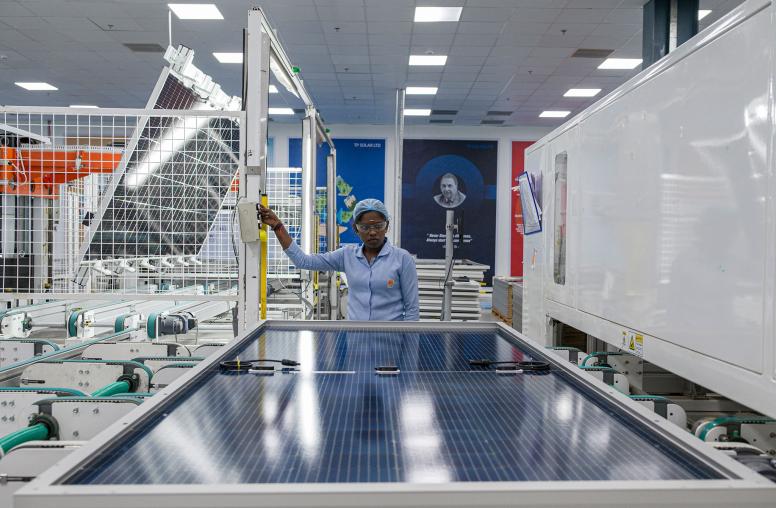Digital Technology’s Evolving Role in Politics, Protest and Repression
The cycle of technological innovation will continue to power a global cat-and-mouse struggle between autocrats and those who oppose them.
The rapid adoption of digital technologies has fundamentally changed global politics. During the Arab uprisings, experts heralded digital technologies as powerful tools for social change and liberation. A decade later — with global democracy in retreat — the script has flipped and authoritarian governments are on the offensive in deploying digital tools to monitor, track and control their citizens. Indeed, the rapid emergence of these tools has ushered in a new era of political repression, says Steven Feldstein, the author of “The Rise of Digital Repression: How Technology is Reshaping Power, Politics, and Resistance.” He explains how digital repression works, China’s role in exporting such technologies and the broader implications for global conflict and democracy.

What do you mean by digital repression? And how are new digital technologies changing how power is wielded around the globe?
In my book, I define digital repression as “the use of information and communications technology to surveil, coerce, or manipulate individuals or groups in order to deter specific activities or beliefs that challenge the state.” I organize digital repression into five categories of techniques: surveillance, censorship, social manipulation and disinformation, internet shutdowns, and targeted persecution of online users. In many cases, these techniques can overlap: Disinformation is both a way for governments to manipulate or distort the truth, but also as a tool of censorship (especially when using tactics known as “flooding,” where legitimate critics of government policies are drowned out by a flood of pro-government posts). One important insight about digital repression is that it operates in a larger ecosystem of political repression; my research shows that a government’s curtailment of political civil liberties — censoring political speech, preventing groups from organizing, restricting academic freedom or banning political parties — is causally related to the deployment of digital repression.
But are digital strategies fundamentally changing the nature of how a government exerts control over its citizens? The short answer: it depends. As I lay out in the book, in states characterized by extensive repression and supported by high-capacity security or intelligence agencies, digital technology can have a transformative effect. In such countries — think China or Russia — digital repression tools not only reinforce existing repression, but they can potentially transform the state’s ability to track political opponents and quash protest movements. However, in lower-capacity countries, such as Bangladesh or Uganda, which lack disciplined security forces or coherent command and control structures (let alone highly trained personnel who can analyze, interpret and act on relevant information), the effect of these techniques is more limited.
In your research, did you find that it was mostly authoritarian governments that engaged in digital repression? Were there instances of democracies engaging in similar tactics, even if in slightly different ways?
My research concludes that authoritarian countries are far more likely to carry out digital repression activities compared to democracies. Particularly when comparing authoritarian states to liberal democratic states, there is a substantial digital repression gap. However, many weak or fragile democracies also deploy digital repression strategies. Countries such as India, Brazil, Turkey, the Philippines (profiled in my book), Nigeria, Serbia and Hungary are responsible for deploying an array of techniques, from internet shutdowns (India leads the world in shutdowns), social media disinformation (Philippines’ President Rodrigo Duterte has staked his rule on his ability to systematically distort online information), to social media censorship (Nigeria recently banned Twitter use in the country; Turkey has instituted a new social media law with burdensome content removal and localization requirements). Generally, democracies favor using information manipulation tactics — such as disinformation campaigns — over more heavy-handed approaches, like mass surveillance or widespread censorship filtering of websites. But the notion that democracies do not rely on digital repression tactics simply is not true.
When it comes to these new technologies, who has the advantage, governments or social movements?
Advantages in digital technology ebb and flow based on one side’s ability to adapt to new technology and to come up with innovative uses of these tools. For example, the onset of social media played an important role in mobilizing mass demonstrations in the Arab world in 2011. As a result of these protests, governments in the region and beyond picked up important lessons about how to exploit the very same technologies to blunt the spread of protests — and more importantly — to monitor and track the very same demonstrators who were fomenting unrest against their governments.
Digital tools offer many uses, both for civic activists to communicate with like-minded individuals to protest governments, as well as for regimes to track dissenters and government critics (and to act accordingly). My own estimation is that the cycle of technological innovation will continue to power a global cat-and-mouse struggle between autocrats who seek to exploit communication technologies for political gain, and civic and opposition members who will leverage the same tools against these regimes.
China has been one of the global leaders in developing technologies and systems of digital repression. Is China looking to export this model to other countries? Is this something the international community should be worried about?
China’s diffusion of digital technology is shaping data governance and leading to negative policy outcomes; sometimes these actions directly reinforce digital repression. An important aspect of China’s influence is “parallel modeling” — where China offers a model to other states about how to deploy digital repression to control citizens (best described as a watch and learn approach for would-be authoritarians). China also supplies digital infrastructure and platforms, such as 5G capabilities or safe city systems, that incorporate surveillance and censorship components. Over time, this may allow Beijing to insert itself into data governance regimes overseas, thereby “shaping the conditions” under which certain states transition toward digital economies and societies.
Some experts contend that China is attempting to exert greater influence on multilateral standard-setting bodies by placing its citizens in key leadership posts and standard-setting bodies (although its actual success in carrying out this agenda is disputed). China’s cyber sovereignty or information security push, backed up by the likes of Russia and Iran, is also cause for concern and over time threatens the prevailing open internet model. Finally, Beijing has also shown a willingness to exploit Chinese networks and internet platforms to advance its national interests, such as conducting surveillance and censorship filtering over WeChat or carrying out “transnational repression” against overseas Chinese diaspora and exile communities.
However, it is important to recognize that Chinese companies aren’t the only firms supplying repressive tools to autocrats. They face stiff competition from companies based in democracies. As the Washington Post’s recent expose of Israeli spyware supplier NSO Group shows, military-grade software was used to successfully hack devices belonging to “journalists, human rights activists, business executives” and even two close associates of slain Saudi journalist Jamal Khashoggi. Far from an isolated example, this demonstrates a bigger pattern — such as Sandvine providing censorship technology to Algeria and Uzbekistan or Oracle selling surveillance equipment in China — exemplifying that Western companies are willing suppliers of potent tools to bad governments.
Another example profiled in my book relates to the Philippines. Chinese companies are partnering with Duterte’s government to install safe city surveillance in Manila — a development widely reported by media outlets. But surveillance measures are really a side activity to the main repression strategy of Duterte’s regime — deploying disinformation campaigns to spread false government propaganda and leveraging social media to harass and intimidate government critics. However, the primary medium used to propagate Duterte’s disinformation strategy originates from a U.S. company — Facebook. This raises a disquieting question: which entity is more responsible for abetting Duterte’s digital repression push, Chinese surveillance firms or Facebook?
My general takeaway is that China’s motivation for selling repressive technologies is based more on economic interests than a grand strategy to impose authoritarian values and alternate governance systems in host states. My own analysis — alongside the research of other scholars — indicates that more relevant factors driving the adoption of digital repression tools are domestic “push” dynamics, such as political leadership incentives, security force capacities, technological capabilities and political norms and practices. While China’s supply-side “pull” factors cannot be ignored, we risk overstating their impact to the detriment of other important explanations.
What does this all mean for civil society, social movements and actors looking to advance democracy and build a more peaceful world?
I believe that technology will continue to serve as a medium of struggle between civic movements, opposition actors and citizens seeking more political freedoms, and governments intent on denying rights to these individuals. As I wrote in the concluding chapter of my book, this story has yet to be decided: “Technology doesn’t stand still. It exists in a constant state of iteration and advancement. This means that while digital technology has fueled a shift toward autocratization, I am certain that circumstances will change many times over in the future.” Just as groups like Bellingcat, the Citizen Lab, the Belarusian Democracy Movement, Myanmar’s Spring Revolution, and a host of others are risking their lives to hold human rights violators to account and to organize against dictators, authoritarians continue to innovate new digital strategies to stay in power.
Steven Feldstein is a senior fellow for the Carnegie Endowment for International Peace’s Democracy, Conflict, and Governance Program.



